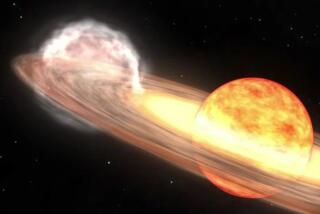A massive, glowing peanut shape in the Milky Way [PHOTOS]
There is a massive, glowing, bulge in the center of the Milky Way galaxy, and scientists say it is shaped like a giant peanut.
In the photo gallery above, you will find an artist’s conception of what this lumpy center might look like, if you could view our galaxy side-on in space.
Continue to click through the images and you will see a gorgeous real-life picture of the galaxy taken on a clear night in Chile. Look closely, and you should be able to make out a faint bulge in the bright yellow center of the galaxy disk.
Keep clicking and you’ll find a star-filled image taken as part of the VISTA Variables in the Via Lactea Survey (VVV), using the European Southern Observatory’s VISTA telescope, based in the Atacama Desert in Chile. The image shows a patch of sky in the direction of the center of the Milky Way, and includes stars that form part of the intriguing bulge.
Our sun lies 27,000 light-years from the central region of the Milky Way, where a huge cloud of 10,000 million stars spans thousands of light-years, according to a release from the ESO.
From here on Earth, this region has been difficult to observe, obscured by clouds of dust and gas. But VISTA uses near-infrared radiation, which lets it penetrate the interstellar haze.
Now, scientists at the Max Planck Institute for Extraterrestrial Physics (MPE) in Germany have used data collected by VVV to create the most detailed 3D map of the bulge to date.
To create the map, the scientists looked specifically at red clump giant stars, which have the advantage of shining with the same brightness no matter how old or big they may be.
“If we see a red clump star and it is bright, then it is close,” explained Christopher Wegg, a post-doc at MPE who led the research, in an email to the Los Angeles Times. “We estimate distances and position on the sky of millions of stars, and by placing them on a map, we calculate our three-dimensional density.”
Wegg added that peanut shapes have been observed in the center of other disk-shaped galaxies as well. (You’ll find an image of one of those galaxies, known as NGC 4710, in the gallery above.)
So, how did this peanut shape form in the first place?
“The short answer is gravity,” wrote Wegg.
Computer models have shown that eventually, over the course of a few billion years, a thin disk of stars will create a bar of stars in the center of the disk, due to gravity.
“This thin bar is unstable and a few billion years later it violently changes in a process known as buckling,” wrote Wegg.
The result is the bright, wavy peanut shape you see above.
Return to the Science Now blog.







